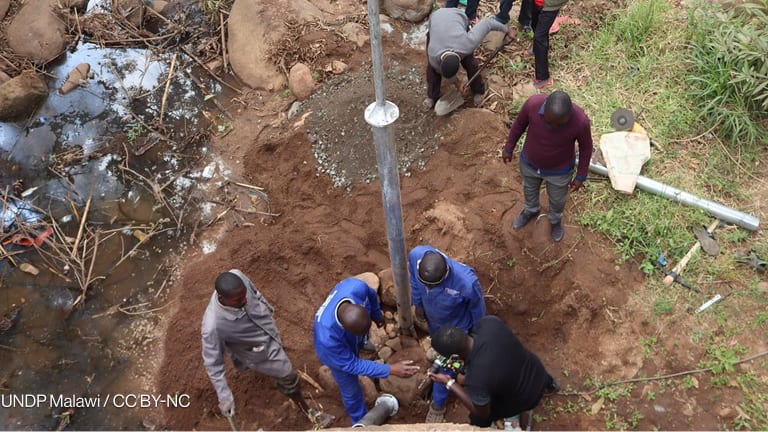Opinion: Emission cuts in Africa miss the mark — adaptation must come first
African countries must move from “distributed carbon emission guilt" to people-centered climate action — with finance for adaptation from wealthier countries a priority.
African governments’ climate action strategies, specifically those submitted under the nationally determined contributions, remain disproportionately focused on emission reductions — an approach that fails to address the most pressing health needs of African communities. For many Africans, it’s hard to explain why their leaders prioritize reducing emissions which are rather low and insignificant when the immediate threat of climate change is not their carbon footprint but their vulnerability to its effects. Consider the Democratic Republic of Congo. With a per capita carbon emission of just 0.04 metric tons, an average Congolese citizen would need over 400 years to match the emissions of a citizen in a high-income country such as the United States, Canada, or Australia. However, DRC’s NDC includes a commitment to reduce emissions by 2% based on national efforts, with a total target of 21% (including external support) by 2030 — a target that comes with a hefty price tag of $25.6 billion for mitigation compared to $23.1 billion for adaptation. This isn’t a critique of DRC’s commitments but an illustration of the absurdity prevalent across African NDCs. Throughout the continent, mitigation costs frequently exceed adaptation investments, despite Africa’s minimal contribution to global emissions. What impact would DRC’s 21% reduction from 0.04 to 0.0316 metric tons per capita emissions have on the global climate at a cost of $25.6 billion? Ethiopia provides another example. With per capita emissions of 0.2 metric tons, Ethiopia aims to cut emissions by 68.8% by 2030. Of its $316 billion climate action budget, $275.5 billion is dedicated to mitigation, while only $40.5 billion is allocated to adaptation. This imbalance overlooks Ethiopia’s pressing need for climate-resilient infrastructure in health, water, and sanitation to protect millions from climate-induced floods and droughts. The trend continues in Malawi, where per capita emissions are only 0.1 metric tons. Malawi’s NDC targets a 6% reduction based on national efforts and a 51% overall reduction by 2040, with $41.8 billion allocated for mitigation but only $4.5 billion for adaptation. This focus on mitigation underfunds Malawi’s immediate vulnerabilities, such as water scarcity, food insecurity, and a fragile agricultural sector. Zimbabwe and Uganda follow similar patterns. Zimbabwe, with per capita emissions of 0.9 metric tons, aims to reduce emissions by 40% by 2030, budgeting $4.83 billion for mitigation compared to just $2.35 billion for adaptation. Uganda, with emissions at 0.1 metric tons per capita, commits to a 24.7% reduction by 2030, with $16.7 billion allocated for mitigation and $11.4 billion for adaptation, despite recurring droughts that jeopardize agriculture and health systems. Distributed carbon guilt This fixation on mitigation in countries with negligible emissions reveals what I call a “distributed carbon guilt” — a shared sense of responsibility for a problem these countries did not create. African nations seem trapped in a copy-paste climate agenda that mirrors the priorities of high-emission countries, rather than building strategies rooted in local needs. Achieving this scale of change requires harnessing the power of citizen engagement to build a groundswell of advocacy that places people at the heart of climate negotiations. Empowered African voices — from grassroots activists to government representatives — are essential in holding wealthier nations accountable, demanding they fulfill commitments for a just energy transition, and offering the financial and technological support that Africa urgently needs to protect its communities. Adaptation investments in Africa provide immediate protection, reduce future risks, and avoid the growing costs of inaction. According to the Global Commission on Adaptation, investing $1.8 trillion in early warning systems, climate-resilient infrastructure, sustainable agriculture, and water management could yield $7.1 trillion in benefits. African farmers could avoid a projected 30% drop in yields by 2050 if they adopted solar-powered irrigation, resilient crops, and weather alert systems. Investing in adaptation thus offers substantial co-benefits for resilience and mitigation alike. A focus on African governments should therefore refocus on four key areas: strengthening climate-resilient health systems; offering reliable safe water and sanitation services; supporting sustainable agriculture mitigation especially where there are direct co-benefits; and implementing social protection programs. Climate-resilient health systems are essential for managing climate-driven health risks, such as rising disease burdens from malaria, dengue, and respiratory illnesses linked to pollution and extreme temperatures. They also play a critical role in responding to health impacts from extreme weather events, such as droughts and floods. Reliable water and sanitation infrastructure that can withstand prolonged droughts and unpredictable rainfall is essential for tackling Africa's growing water scarcity, thus reducing the risk of diseases such as cholera. In agriculture, climate-smart practices — such as resilient crop varieties, agroforestry, improved irrigation, and early warning systems — are necessary for ensuring food security. And government-led social protection programs serve as a safety net for communities facing economic impacts from climate shocks. These priorities will form a central part of discussions at next year’s Africa Health Agenda International Conference, or AHAIC25, in Kigali, where African leaders will host global health and development partners to exchange best practices and innovative solutions for tackling these urgent challenges. According to the principle of Common but Differentiated Responsibilities and Respective Capabilities, Africa should not shoulder the financial burden of adaptation alone. High-income countries, whose emissions have driven the climate crisis, have a moral responsibility to support affected developing nations. The Paris Agreement on climate change mandates low- and middle-income countries to provide financial support, yet funding has not been delivered at the required scale or speed. At the 29th U.N. Climate Change Conference, COP29, African leaders must stand together to demand substantial, immediate financial support from wealthier nations to fund adaptation efforts across the continent, as the world seeks to mitigate the global warming catastrophe. With the next round of NDCs due in 2025, African policymakers must shift focus to meet their countries’ most pressing needs. Adaptation should be the primary consideration, supported by data highlighting Africa’s urgent need for resilience. Mitigation should be pursued selectively, where it brings direct benefits, such as reducing indoor air pollution. Meanwhile, the Group of 20 major economies, especially the highest emitters, must take the lead in global mitigation efforts. Prioritizing emission reductions in low-emission African countries is tantamount to adopting someone else’s agenda, diverting attention from Africa’s urgent needs. Africa’s leaders must champion a strategy that safeguards its people, builds robust systems, and prepares for the climate impacts already upon us.
African governments’ climate action strategies, specifically those submitted under the nationally determined contributions, remain disproportionately focused on emission reductions — an approach that fails to address the most pressing health needs of African communities.
For many Africans, it’s hard to explain why their leaders prioritize reducing emissions which are rather low and insignificant when the immediate threat of climate change is not their carbon footprint but their vulnerability to its effects.
Consider the Democratic Republic of Congo. With a per capita carbon emission of just 0.04 metric tons, an average Congolese citizen would need over 400 years to match the emissions of a citizen in a high-income country such as the United States, Canada, or Australia. However, DRC’s NDC includes a commitment to reduce emissions by 2% based on national efforts, with a total target of 21% (including external support) by 2030 — a target that comes with a hefty price tag of $25.6 billion for mitigation compared to $23.1 billion for adaptation.
This article is free to read - just register or sign in
Access news, newsletters, events and more.
Join usSign inPrinting articles to share with others is a breach of our terms and conditions and copyright policy. Please use the sharing options on the left side of the article. Devex Pro members may share up to 10 articles per month using the Pro share tool ( ).
The views in this opinion piece do not necessarily reflect Devex's editorial views.
Dr. Githinji Gitahi is group chief executive officer of Amref Health Africa, the largest Africa-led international organization, reaching more than 11 million people each year through 150 health-focused projects across 35 countries. Previously, Dr. Githinji was vice president and Africa regional director for Smile Train International; managing director for Monitor Publications in Uganda; and general manager for marketing and circulation in East Africa for the Nation Media Group. Dr. Githinji also sits on the boards of the Africa Centres for Disease Control and Prevention and The Coalition for Epidemic Preparedness Innovations.








